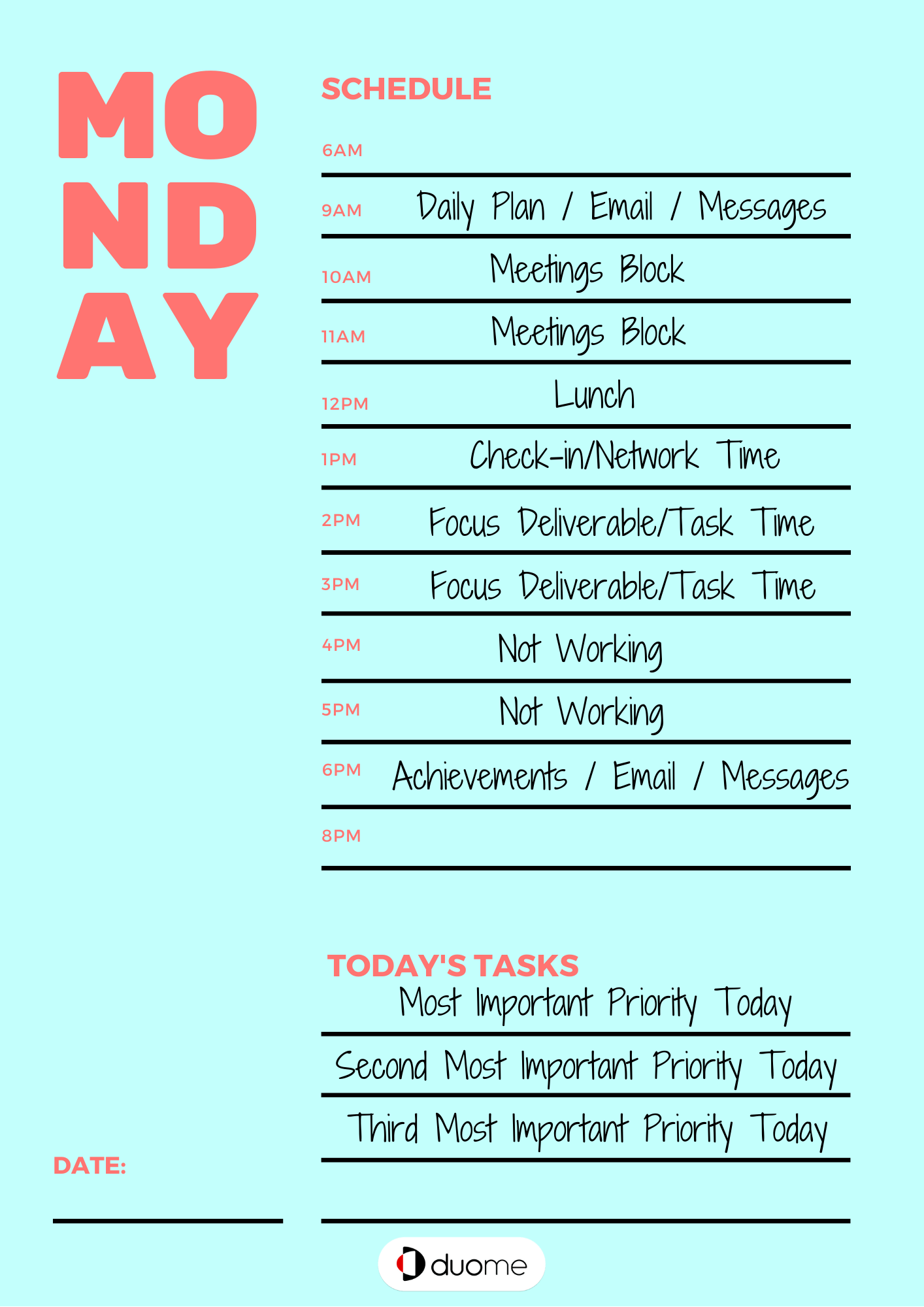Working remotely can improve your work-life balance, but how do you stay focused with so many tempting distractions? Creating a remote work plan is one handy way to keep on track – use it to add structure to your day, organise your work efficiently, and stay in touch with colleagues. And its not just for people who are remote full-time, hybrid workers need to plan their remote time along side hybrid work scheduling for when to be in the office.
To create a successful plan, you will need to strike a careful balance between the needs of the business and your lifestyle. This will involve giving some consideration to working hours, for instance contemplating whether you are more productive in the morning or after lunch. You will also need to decide how you will limit distractions, and apportion your time to deal with specific jobs, such as checking emails etc.
What to plan when working remotely
You might be in striking distance of your kettle, but there’s more to get to grips with than working out when you can take a break. Remote working calls for self-motivation, concentration, and an abundance of self-discipline. So without further ado, take a seat and grab your notepad – it’s time to put together a savvy remote work plan.
Plan Your Working Hours
First off, give some thought to your working hours. It goes without saying that these need to be in line with company requirements, however, remote working often allows for a degree of flexibility. Outline your availability and let people know when you are “in the office.” Don’t forget to block out non-working hours too (you are still entitled to a lunch break)!
Build-in Time to Focus on Deliverables
Busy workdays are par for the course, but sometimes it seems like everyone wants a slice of your precious time. If you’re not careful, you could find yourself attending an online team briefing in the morning, followed by meeting after meeting with various colleagues, and endless discussions with others from outside your organisation. Whilst online meetings provide an excellent opportunity to socialise (as well as chew over important strategies, ideas and decisions) they can take over your working day.
Where possible, have set times to schedule meetings, e.g. try requesting all online meets to take place before noon. You can also look into consolidating individual appointments, e.g. rather than holding two separate meetings to talk with different peers about the same project could you invite both to a joint discussion? This might not work for every scenario, but where possible, try to avoid spending your whole day engaging with others.
And finally, make sure you leave enough quality time for yourself to get your work done. Most people advocate scheduling the most important thing you have to get done in a day first. It’s a technique called eating the frog, and it helps to ensure you get the most important priority done.
Check-in and Network
So, it’s looking more and more as though the key to devising a high-quality remote work plan is to allow enough time to doggedly work on tasks and correspond with others. There’s no doubting the importance of effective communication, and there’s much to be gained by networking.
Building robust relationships with others can benefit you greatly, whether you work in a busy office or remotely. Taking time to converse with people can open a variety of doors, provide useful insight and present opportunities. It’s also vital for your sanity! Remote working can be a solitary affair – talking to others can boost your productivity, kickstart your brain and make you feel less like it’s you versus the world! In fact, telling someone about what you plan to achieve in a day or week makes you more likely to actually get the work done.
As well as general networking, you also need to allow time to check-in with contacts – be that colleagues, suppliers, customers or your boss! Endeavour to return calls and emails in good time, and don’t forget to pick up voice mail messages. Try to do this at set periods throughout the day by incorporating periods for communication into your remote work plan. This will prevent you from getting distracted every time a message notification pings your way.
It’s also a good idea to have a discussion with those you work with regarding expectations and timelines. This will hopefully help to stave off awkward conversations – tensions can rise when people start to think they are being ignored or that a colleague isn’t pulling their weight. It’s also wise to check in regularly with team leads or team members especially if you frequently seek their help!
Update on Progress and Share Successes
Reporting on your progress not only affords colleagues an overview of your progress but will also provide you with a sense of achievement. As a remote worker, you may need to go that extra mile to demonstrate that you are being proactive.
Factor in time to tell colleagues about the activities you’ve been carrying out (and to share accomplishments). This can be achieved by sending a daily or weekly round-up email or blog post. Doing this will also help you to maintain focus on those long-term goals and reduce the number of calls you get to find out what you’re working on.
Make sure you take time to explain to your manager what you are achieving and if you need help. This may sound glaringly obvious but as you spend less time in the office, updates that previously occurred coincidentally, like quick chats in the corridor, start to get missed. Creating a standard template you provide to your manager, whether you use it to drive a live discussion or sent via email, helps to keep the cycle of updates consistent and clear.
Turn off Phone Notifications
It can be difficult to escape when your home is also your workplace, but you need to do your utmost to separate your job from your personal life. Aside from scheduling breaks, you also need to decide on a cut-off time. Turning off your phone notifications at a set time such as 6pm allows you time to wind down.
Don’t peak at the screen after that time – your messages will still be there in the morning. You will be more productive if you take time away from your laptop and mobile. Eat dinner, go for a run, socialise with friends and family and get a good night’s sleep.
Ready to Create Your Remote Work Plan?

Given the current unsettled climate, it’s no surprise to learn that remote working is on the rise. A report by FlexJobs – Remote Work Statistics for 2019 indicates that the remote workforce has increased by 44% over the past five years and a whopping 91% over the past ten years. With businesses looking to cost costs by saving on rent and overheads, and the advance of the digital age, it’s almost certain that this trend is set to continue.
If you’re keen to go remote, you could enjoy greater flexibility (you can’t beat working in the garden on a warm summer’s day), and more time to devote to other areas of your life. However, when you are working, you will need to knuckle down and set your mind to the tasks at hand. Putting together a practical remote plan will help you to stay on that all-important track.
Frequently Asked Questions (FAQ)
Does working remotely work?
Remote working is shown to increase the productivity of employees that have the discipline and structure to prioritise their time and the activities they need to achieve. Some very successful companies have been operating their entire workforce as remote for many years such as Gitlabs, see their guide to remote here.
How can I be more productive working remotely?
Setting the right priorities is key, knowing what’s the most impactful set of things to work on creates focus. Additionally, remove activities that are not high value for your role, treat your time like the precious resource it is. Finally, setting aside focused time to work uninterrupted on key tasks is probably the biggest productivity enhancer there is. That’s why having a remote working plan is so important, allocate quality time to do what gives you the most benefit.
How should I prioritise what to work on next?
Separate tasks out into what is important vs urgent. In most instances, the task that is important and urgent should be the next task to work on. Remember importance is relative, make sure the tasks are important to you and how you are rated in your position. Don’t let others overly distract you from what you must achieve to perform your role well.
In Summary
Creating a plan for when you work remotely helps you structure how to spend your time, prioritise what needs to get done, and recognise key things to do like sharing achievements or networking. Communicating the hours you plan to work and recognising the end of your working day are important to avoid feeling overworked and ensure there’s a separation from work whilst still at home.







